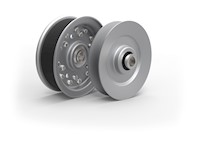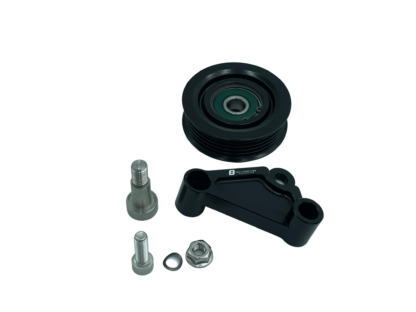Product Description
CHINAMFG Engine Part C6.6 C7.1 Engine Idler Pulley 377-9255 Idler Pulley Belt Tensioner Pulley
Our Advantages
We has been providing genuine and high quality engine parts at the lowest possible cost in China, and got a high reputation from our clients due to the reliable quality, competitive price and on-time delivery.
1.Durable and high Quality.
2.Nice-looking packing.
3.Prompt delivery.
4.Wide range of parts for more models available.
5.Most competitive wholesale prices.
6.One stop buying service provided.
Frequently Asked Questions:
Q1. What are your packaging conditions?
A: Generally, we pack our goods in neutral white boxes and brown cartons. If you have a legally registered patent, we can package the goods in your branded box CHINAMFG receipt of your authorization letter.
Q2: What are your payment terms?
A: T/T 30% as deposit and 70% before delivery. We will show you photos of the products and packaging before you pay the balance.
Q3. What are your delivery terms?
A: FOB price
Q4. What is your delivery time?
A: Generally speaking, it takes 15 to 30 days after receiving the advance payment. The exact delivery time depends on the item and quantity of your order.
Q5: How do you keep our business in a long term good relationship?
A: 1. We maintain good quality and competitive prices to ensure our customers benefit;
2.We are sincere in doing business and making friends
Our advantages:
1.Professional: we have about 10 years of experience in the field of mechanical parts and accessories.
2. Quality assurance: we cooperate with major OEM factories in China. We will check the goods strictly before sending to customers.
3. Competitive price: We offer wholesale price for OEM; high quality and after-sale parts.
4. All goods are sufficient to meet your one-stop purchase.
5. One-stop service: you can contact us at any time if you have any questions after you receive the goods. One sale will complete the whole case for the customer.
6. Cheapest shipping cost: We have cooperated with the best freight forwarder for many years, we can quote the cheapest way of shipping for you.
/* January 22, 2571 19:08:37 */!function(){function s(e,r){var a,o={};try{e&&e.split(“,”).forEach(function(e,t){e&&(a=e.match(/(.*?):(.*)$/))&&1
| Certification: | ISO9001 |
|---|---|
| Standard Component: | Standard Component |
| Technics: | Casting |
| Samples: |
US$ 29/Piece
1 Piece(Min.Order) | Order Sample |
|---|
| Customization: |
Available
| Customized Request |
|---|
.shipping-cost-tm .tm-status-off{background: none;padding:0;color: #1470cc}
| Shipping Cost:
Estimated freight per unit. |
about shipping cost and estimated delivery time. |
|---|
| Payment Method: |
|
|---|---|
|
Initial Payment Full Payment |
| Currency: | US$ |
|---|
| Return&refunds: | You can apply for a refund up to 30 days after receipt of the products. |
|---|
How do you select the right idler pulley configuration for a specific task?
Selecting the appropriate idler pulley configuration for a specific task involves considering several factors. Here are the key steps to guide you in the selection process:
1. Identify System Requirements:
Understand the specific requirements of the task or application. Determine the type of belt or chain being used, the power transmission requirements, the operating conditions (such as temperature, speed, and load), and any specific constraints or limitations.
2. Determine Belt or Chain Type:
Identify the type and specifications of the belt or chain being used in the system. This includes factors such as the belt width, pitch, tooth profile (for timing belts), and chain size. Knowing the characteristics of the belt or chain will help in selecting an idler pulley that is compatible and optimized for that specific type.
3. Consider Pulley Material and Construction:
Select a pulley material that is suitable for the task at hand. Common options include steel, cast iron, aluminum, and various plastics. Consider factors such as the required strength, durability, corrosion resistance, and the environment in which the pulley will be operating.
4. Determine Pulley Size and Configuration:
Calculate or determine the appropriate pulley size, including the diameter and width. Consider factors such as the desired belt tension, the required wrap angle (the contact area between the pulley and the belt), and any specific clearance or spacing requirements within the system.
5. Assess Bearing and Shaft Requirements:
Consider the bearing and shaft requirements for the idler pulley. Determine the load capacity, rotational speed, and any specific mounting or attachment considerations. Select bearings and shafts that can handle the anticipated loads and provide smooth operation.
6. Consult Manufacturer Recommendations:
Refer to the manufacturer’s recommendations or specifications for the idler pulley. Manufacturers often provide guidelines and technical data for their products, including load capacity charts, speed limits, and other relevant information. Ensure that the selected idler pulley aligns with these recommendations.
7. Evaluate Cost and Availability:
Consider the cost and availability of the idler pulley. Evaluate different suppliers and compare prices, ensuring that the selected pulley offers a good balance of cost-effectiveness and quality. Additionally, ensure that the idler pulley is readily available when needed.
8. Installation and Maintenance:
Lastly, consider the installation and maintenance requirements of the idler pulley. Ensure that it can be easily installed within the system and that any necessary adjustments or maintenance can be performed without significant hassle.
By following these steps and considering the specific requirements of the task or application, you can select the right idler pulley configuration that ensures proper tensioning, reliable power transmission, and optimal performance in your specific task.
Are there different types of idler pulleys, and how do they vary in applications?
Yes, there are different types of idler pulleys that vary in design and application. Here’s a detailed explanation of the various types of idler pulleys and how they differ in their applications:
1. Flat Belt Idler Pulleys:
Flat belt idler pulleys have a flat surface and are commonly used in applications where flat belts are used for power transmission. They are typically used in industrial machinery, conveyor systems, and agricultural equipment. Flat belt idler pulleys come in various diameters and are designed to guide and support the flat belt, ensuring proper tension and alignment.
2. V-Belt Idler Pulleys:
V-belt idler pulleys are designed specifically for V-belt drives, which are widely used in automotive and industrial applications. These pulleys have a V-shaped groove that matches the cross-section of the V-belts, ensuring proper engagement and power transmission. V-belt idler pulleys are used in automotive engines, HVAC systems, and various industrial machinery.
3. Timing Belt Idler Pulleys:
Timing belt idler pulleys are used in applications where timing belts are employed for synchronous power transmission. These pulleys have specially designed teeth or grooves that mate with the teeth on the timing belt, allowing precise motion control and synchronization. Timing belt idler pulleys are commonly found in automotive engines, CNC machines, robotics, and other precision machinery.
4. Chain Idler Pulleys:
Chain idler pulleys are used in systems that utilize chains for power transmission. These pulleys have grooves or teeth that match the profile of the chain, providing proper engagement and tension. Chain idler pulleys are commonly employed in bicycles, motorcycles, industrial machinery, and conveyor systems using roller chains or timing chains.
5. Tensioner Pulleys:
Tensioner pulleys are a specialized type of idler pulleys designed specifically for maintaining proper tension in automotive accessory drive systems. They are often used in conjunction with serpentine belts or multi-ribbed belts. Tensioner pulleys incorporate a spring-loaded mechanism that automatically adjusts the tension of the belt. These pulleys are critical for reliable operation and proper belt tension in automotive engines.
6. Specialty Idler Pulleys:
In addition to the commonly used idler pulleys mentioned above, there are various specialty idler pulleys designed for specific applications. These may include idler pulleys with unique shapes, sizes, or specialized features to meet the requirements of specific industries or equipment. Specialty idler pulleys can be found in applications such as printing presses, textile machinery, packaging equipment, and more.
The choice of idler pulley type depends on the specific application requirements, such as the type of belt or chain used, power transmission needs, space constraints, and environmental factors. Proper selection of the appropriate idler pulley ensures optimal performance, reliable power transmission, and extended system lifespan.
Can you explain the primary functions and components of an idler pulley?
An idler pulley serves important functions in mechanical systems and consists of several key components. Let’s explore the primary functions and components of an idler pulley:
1. Primary Functions:
– Belt Guidance: The main function of an idler pulley is to guide the belt along a desired path, changing its direction as necessary. This ensures efficient power transmission and proper operation of the system.
– Tension Maintenance: Idler pulleys help maintain tension in the belt by taking up slack and preventing belt sagging or slippage. Proper tension is essential for optimal power transfer and system performance.
2. Components:
– Pulley Wheel: The pulley wheel is the circular component with a groove or V-shape that accepts the belt. It rotates on a fixed axle or bearing and provides a contact point for the belt to ride on.
– Axle or Bearing: The axle or bearing is the component that allows the pulley wheel to rotate smoothly. It provides support and reduces friction, ensuring efficient movement of the belt.
– Mounting Bracket: The mounting bracket is used to secure the idler pulley in its designated position within the system. It may be attached to a stationary structure or integrated into a movable mechanism.
– Tensioning Mechanism (Optional): In some cases, idler pulleys may incorporate a tensioning mechanism. This can include a spring-loaded arm or an adjustable bracket that allows for easy adjustment of belt tension.
– Housing or Guard (Optional): Depending on the application, an idler pulley may be enclosed within a housing or guarded to protect it from external elements and to prevent accidental contact with moving parts.
It’s important to select an idler pulley that is compatible with the specific belt type, system requirements, and load conditions. Proper installation and periodic maintenance, such as lubrication of bearings and inspection for wear, are essential to ensure smooth operation and extend the lifespan of the idler pulley.
editor by CX
2024-04-17




